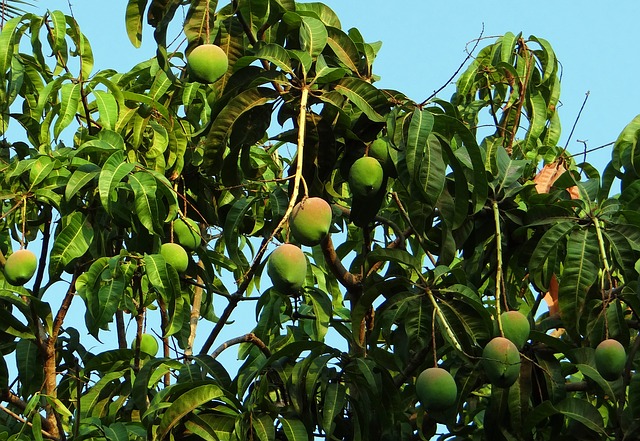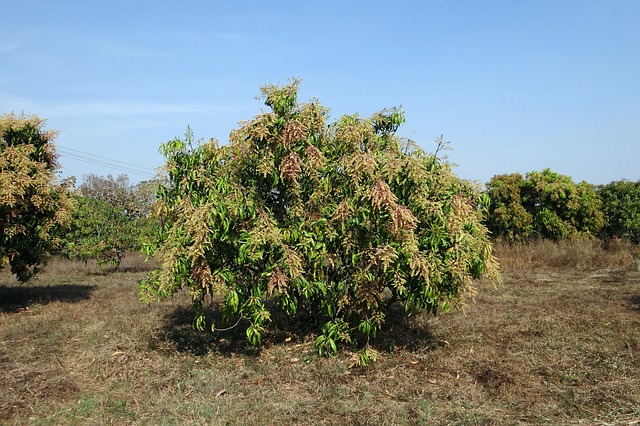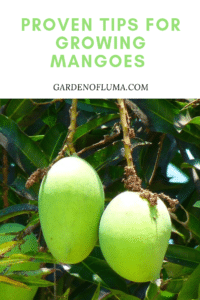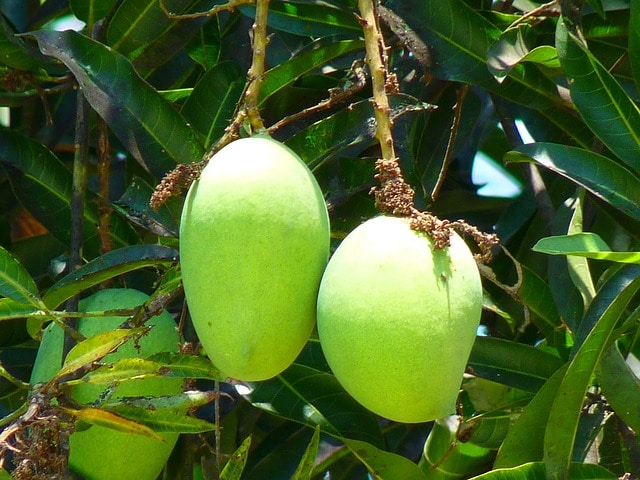Proven Tips for Growing Mango Trees in Hot, Dry Climates

If you’ve ever had the chance to eat a mango from the tropics, you probably immediately fell in love. It’s a totally different experience from the mangoes commonly found in the grocery store. Much of the mangoes shipped are of inferior quality, go through irradiation processes, and are harvested early for shipping.
Naturally, if you live anywhere that’s warmer and have had the pleasure of the flavor explosion from a good mango, then you’ve probably wondered if you can grow a tree of your own. Here in the Phoenix, Arizona desert, we’ve seen an influx of backyard gardening enthusiasts attempting to grow mango trees. As one would expect, growing a mango tree in a hot, dry climate like the desert poses some challenges.
RELATED POST: Growing Mango Trees in Hot, Dry Climates
Mangoes Growing in the Coachella Valley Desert

When I began my Mango growing quest a few years ago, I learned that mangoes were successfully grown in the Coachella Valley, California area which is a desert climate very similar to where I reside in Arizona. Not only were they growing Mangoes, but the trees have been thriving for decades.
Wong Farms is a family operated farm located in Mecca, California. Wong Farms has been growing mangoes successfully for over 30 years. I had the pleasure of trying a Keitt Mango from one of these California growers and it was amazing.
The fruit was unlike anything that I had tried at the store. Recently, I had a chance to ask the growers at Wong Farms in Coachella Valley a few questions regarding some of the challenges we see trying to grow mangoes in Arizona.

Do you guys have challenges with high PH soil and use anything to lower the PH?
We grow in high drainage soil and don’t have problems with alkaline issues. You might contact some local commercial growers in your area and ask about their leaching programs to get rid of accumulated salt. In the Coachella Valley the ground is leached in the summer using calcium sulfate to move the salts down into the leach lines.
Our PH is extremely high in the Arizona Desert. Much of our clay soil is a PH of 8 and higher, whereas mangoes thrive in slightly acidic to neutral soil PH. Our city water also compounds the issue with added salts and PH. Gypsum has long been used as a soil conditioner to help loosen our clay soil, but may need to be more utilized to leach the salts. The addition of soil sulfur is an effective way to slowly bring the PH down over time and should be applied. I use soil sulfur a few times a year, but make sure your applying per instructions.
What do you guys use to fertilize?
Beside the annual addition of compost/steer manure, I will add CaNO3, KNO3, monoammonium phosphate, K-Mag, and MgSo4 depending on the time of year. Go to www.mango.org and navigate to their research section and look at the papers dealing with mango nutrient requirements for recommendations on timing of fertilizer additions.
I was really excited to learn about how they fertilize, as I’m always tinkering with the right combo of nutrients. I’ve been a big fan of liquid seaweed and fish emulsion. I utilize both the 5-1-1 and 0-10-10 varieties of fish emulsion. I haven’t used any granular feeds, due to concerns with salt burns. I also utilize my rabbit manure compost with periodic applications of Manganese sulfate, Chelated Iron (EDDHA), and Magnesium Sulfate.
Click here for my Recommended Garden Tools and Products
Do you guys have any problems with diseases like Anthracnose and use anything for it?
We don’t see a lot of those problems but some citrus growers have told me that a mixture called Bordeaux Solution is used on anthracnose on citrus trees. You can find the mixture directions online – it’s basically a lime and copper sulfate mix that is sprayed or painted on the infected areas.
It’s been up for debate whether or not Anthracnose is prevalent in our desert. Most of the mango trees that come into Arizona have been brought in from Florida where we know Anthracnose is a problem, so some of these trees have been exposed to Anthracnose.
The thinking is that the Anthracnose lies dormant in these trees and the disease will rear its ugly head when climate conditions in our area are just right. Many have claimed that it’s too dry for Anthracnose to be an issue in our desert. The thought is those symptoms of Anthracnose are nutrient deficiencies from the trees inability to pick up needed nutrients in the soil. Whatever the thinking, it still can be helpful to apply a periodic copper spray to remedy potential fungal diseases. This is what I use.
Do you do anything to frost protect or shade protect in the desert sun?
We have been growing mangos at our location since the late 90’s and have not had any frost damage to the mangos. We do spray the tree trunks of the small trees with white latex paint/water mix until the foliage is developed enough to provide shade for the tree base. We also cover the fruit with bags to prevent sunburn spoilage.
The light frosts that we get in our area has been the death of many mango trees. I was surprised to see that frost wasn’t a major issue at Wong Farms in California. After looking up their growing zone on the USDA hardiness map, it still appears that their farm is in zone 9B, which is the same as Phoenix, Arizona.
Maybe they stay slightly warmer or are in a warmer pocket. It could be that the Keitt and Valencia Pride varieties that they grow are slightly more cold tolerant. Nevertheless, mango trees in our area need a microclimate for cold protection at the very least. I utilize frost structures on my in-ground mango trees and move my container tree in the garage on cold nights. Other than protecting the fruits and trunks, it seems shade cloth isn’t necessary.
Do you know the type of rootstock the trees are grafted on?
Most of our trees are grafted onto the turpentine mango rootstock. We have a few that are on Manilla and Nam Doc Mai root stock and they seem to be ok as well. The Israeli’s reportedly developed a new rootstock specifically for desert environments but aside from the marketing hype I haven’t heard if it is actually superior or not – may be too early for evaluation.
I was surprised to learn that most of the mango trees at Wong Farms are on turpentine mango rootstock, which is also the common rootstock of Florida grown mangoes. I was thinking that Manilla may have been more prevalent as it seems to do a bit better as a seedling in our soil conditions and climate.
I’ve seen a few larger seedling Manilla mango trees in our area and they seem to perform well. It’d be interesting to compare this stock to some of the turpentine stock varieties in our soil. I have a seedling mango tree from an Itamaraca mango and it’s far outgrown my grafted varieties that were much larger when initially planted.
Can it be done?

Mangoes can absolutely be grown in the desert and produce quality fruits. Wong Farms is a prime example. Taking some of the tips that work for them as well as what has been effective for others can help you find the formula for success in your backyard. Here in Arizona, the longevity of Mango trees in our climate conditions and the soil is still in the experimental stages.
If you’re a mango enthusiast and are wanting to grow a mango tree in a hot, dry climate continue to learn from those around you. I’d recommend trying to grow a few trees in different ways like one in-ground, one in a container, and one from seed. We love to experiment as gardeners, so be prepared to try different methods to help your mango tree thrive.
Please comment below on anything that you’ve enjoyed from this post or experience regarding growing mango trees in hot, dry climates.
